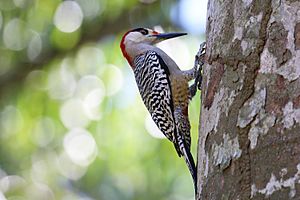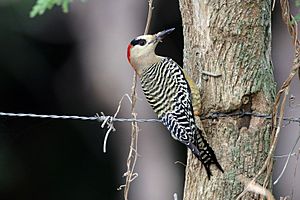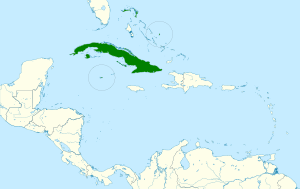West Indian woodpecker facts for kids
Quick facts for kids West Indian woodpecker |
|
|---|---|
 |
|
| Male | |
 |
|
| Female Both M. s. superciliaris on Cuba |
|
| Conservation status | |
| Scientific classification | |
| Genus: |
Melanerpes
|
| Species: |
superciliaris
|
 |
|
The West Indian woodpecker (Melanerpes superciliaris) is a colorful bird. It is part of the woodpecker family. You can find this bird in the Bahamas, the Cayman Islands, and Cuba. These woodpeckers are known for their strong beaks. They use them to find food and make homes in trees.
Contents
Meet the West Indian Woodpecker
Scientists group living things to understand them better. This is called taxonomy. The West Indian woodpecker has a scientific name, Melanerpes superciliaris. It also has different types, called subspecies. Think of them like different breeds of dogs.
There are five main subspecies of the West Indian woodpecker:
- M. s. nyeanus
- M. s. blakei
- M. s. superciliaris
- M. s. murceus
- M. s. caymanensis
Some other types of this woodpecker might have lived on small islands in Cuba. Sadly, these might be extinct now. Another type from Grand Bahama Island is also likely gone.
What Does It Look Like?
The West Indian woodpecker is about 27 to 32 centimeters (11 to 13 inches) long. That's about the length of a ruler. It weighs between 48 and 126 grams (1.7 to 4.4 ounces). Birds on bigger islands are usually larger. Male woodpeckers are also a bit bigger and heavier than females.
Both male and female woodpeckers look very similar. The main difference is on their heads.
- Males: Have a bright red top of the head and back of the neck. They also have a black stripe above their eyes that goes into the red.
- Females: Have a whitish top of the head. Their black stripe goes around to separate the white from the red on the back of their neck.
The rest of their head is white or light yellow-white. Their backs are mostly black with stripes of white or yellowish-white. Their tail feathers are mostly black. They have wide white stripes on the feathers closest to their body and on the outer ones.
Their undersides are grayish. They have a patch of red or orange-red on their belly. Their eyes are red or reddish-brown. Their beak is black, and their legs are olive green.
Young woodpeckers look a bit duller than adults. Their markings are not as clear. Young males have a red patch on their head. Young females have a red head with some black feathers.
Different subspecies have small differences in size and color. For example, M. s. nyeanus and M. s. blakei are much smaller. M. s. caymanensis has no black on its face.
Where Do They Live?
The different types of West Indian woodpeckers live in specific places:
- M. s. nyeanus: Lives on San Salvador Island in the Bahamas. It used to live on Grand Bahama too.
- M. s. blakei: Found on Great and Little Abaco islands in the Bahamas.
- M. s. superciliaris: Lives on the main island of Cuba and many smaller islands nearby.
- M. s. murceus: Found on Isla de la Juventud (Isle of Pines). It might also have lived on Cayo Largo and Cayo Real.
- M. s. caymanensis: Lives on Grand Cayman island.
These woodpeckers like different kinds of wooded areas. On Cuba, they live in many types of forests. They especially like places with lots of royal palm trees. They can live from sea level up to 1,000 meters (3,300 feet) high.
On San Salvador, M. s. nyeanus mostly lives in dense forests with dead palm trees. On Grand Cayman, M. s. caymanensis prefers forests on rocky areas. It avoids city areas and mangroves. M. s. blakei on the Abacos lives in most types of woodlands. It is even common in neighborhoods.
Behavior and Life
Movement
West Indian woodpeckers do not migrate. They stay in the same area all year long.
What Do They Eat?
The West Indian woodpecker eats many different things. Their diet includes:
- Insects and spiders
- Small animals like frogs and lizards
- Seeds and fruits from many plants
They look for food in many places. They search on the ground and at all levels of trees and plants. They find food by picking at surfaces, pecking into wood, and probing into cracks. How they eat and what they eat can be a little different for each subspecies.
Reproduction and Life Cycle
West Indian woodpeckers usually nest between February and August. Sometimes, they have two groups of babies in one year. They often stay with the same partner all year. They also protect their nesting area even when it's not nesting season.
Both the male and female woodpeckers help dig the nest hole. They usually make their nests in dead palm trees or other trees. Sometimes, they even use telephone poles. The nest is typically high up, between 5 and 30 meters (16 to 98 feet) above the ground.
A female woodpecker usually lays five or six eggs. The eggs hatch after about 12 days. We don't know exactly how long it takes for the baby birds to be ready to fly. Both parents take turns sitting on the eggs. They also both feed the baby birds in the nest and after they fly. Most pairs are faithful to each other. However, there was one time a female laid eggs from different fathers in two different nests.
Sounds They Make
The West Indian woodpecker makes a "kwirr" or "churr" sound. It's a loud, rolling call that sounds a bit like a scream. They usually make this sound from a tree branch. They also make a "kra-kra-kra" call.
Like other woodpeckers, they also drum on surfaces. They tap quickly on dead trees or utility poles. This makes a steady, fast drumming sound. They tap about 17 times per second. They also make a slow, soft tapping sound with their beak. This is part of how they show affection to each other.
Status and Conservation
The IUCN (International Union for Conservation of Nature) has listed the West Indian woodpecker as a species of "Least Concern." This means it is not in immediate danger of disappearing. It lives in a large area. However, we don't know exactly how many there are. Scientists believe their numbers might be going down.
There are no big, immediate threats to these birds. They are common in Cuba and on Grand Cayman. But the groups of woodpeckers on some smaller islands are more vulnerable. Woodpeckers have usually recovered well after hurricanes. But with climate change, storms are becoming stronger and more frequent. This might make it harder for the birds to recover in the future. Protecting their homes is the most important thing to help these woodpeckers.
See also
 In Spanish: Carpintero jabado para niños
In Spanish: Carpintero jabado para niños


